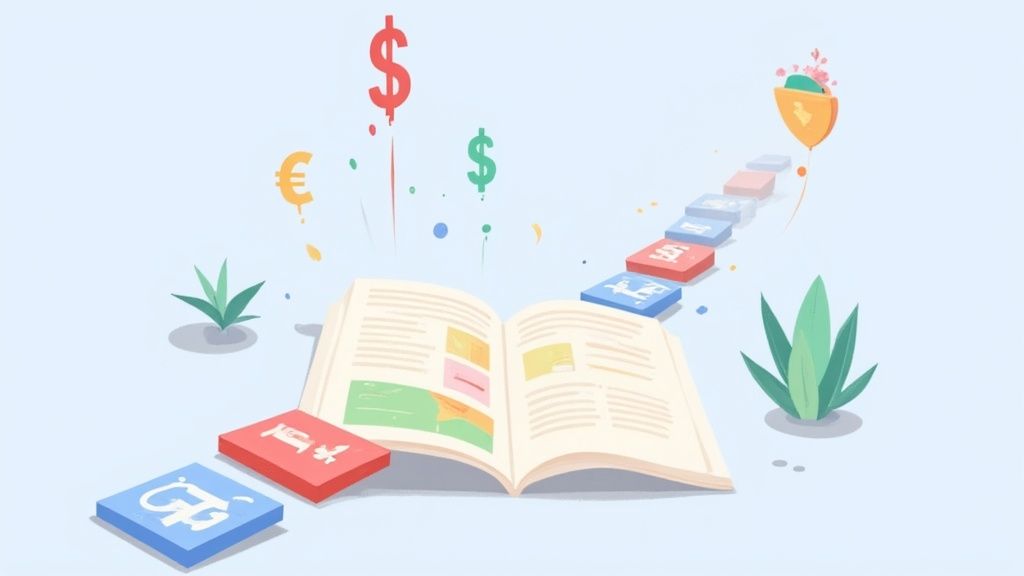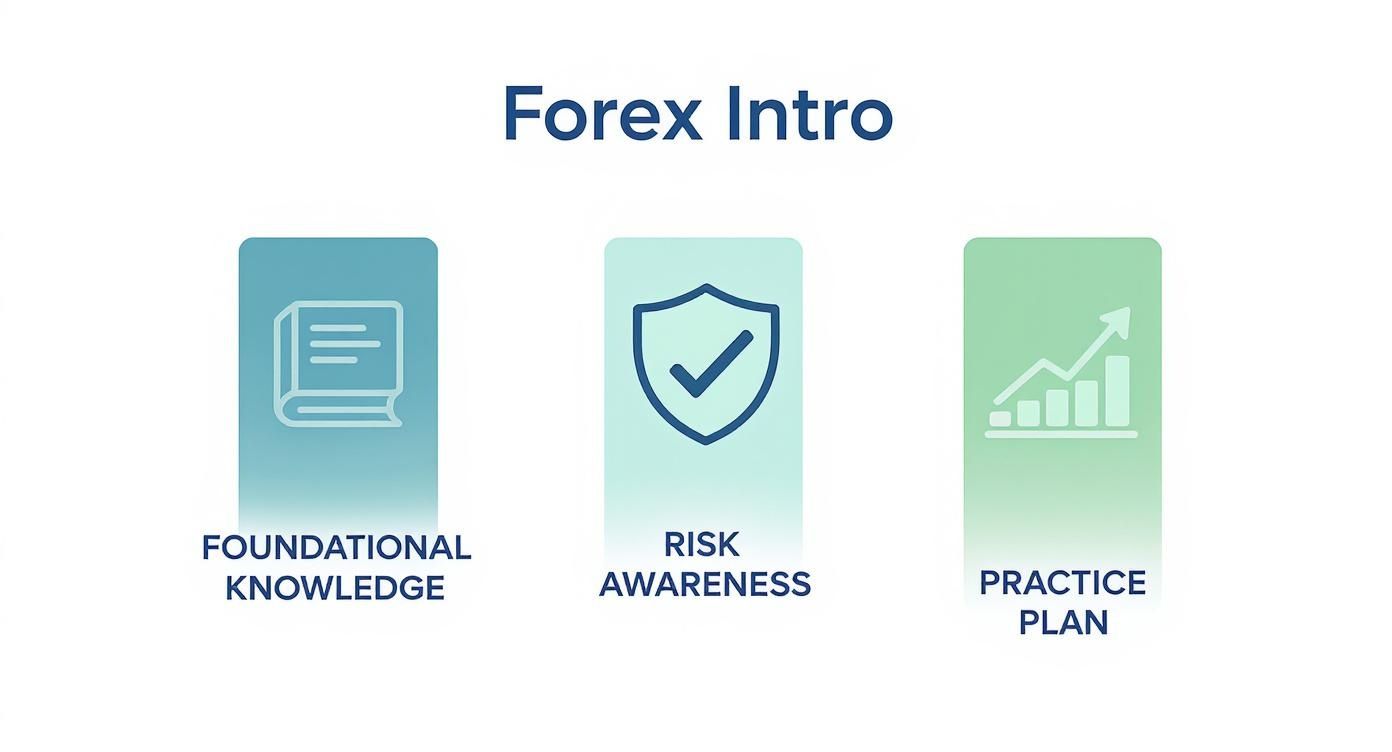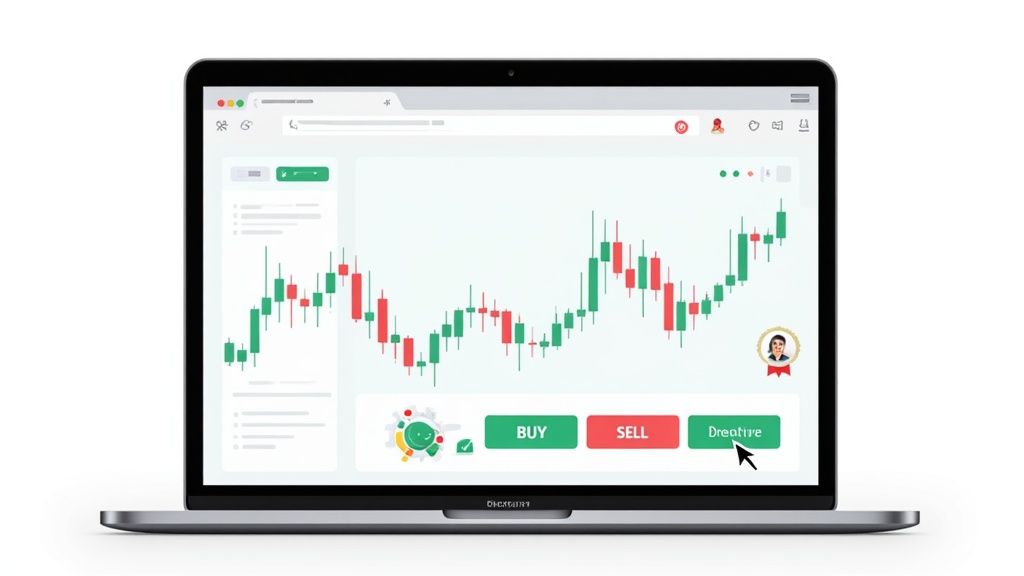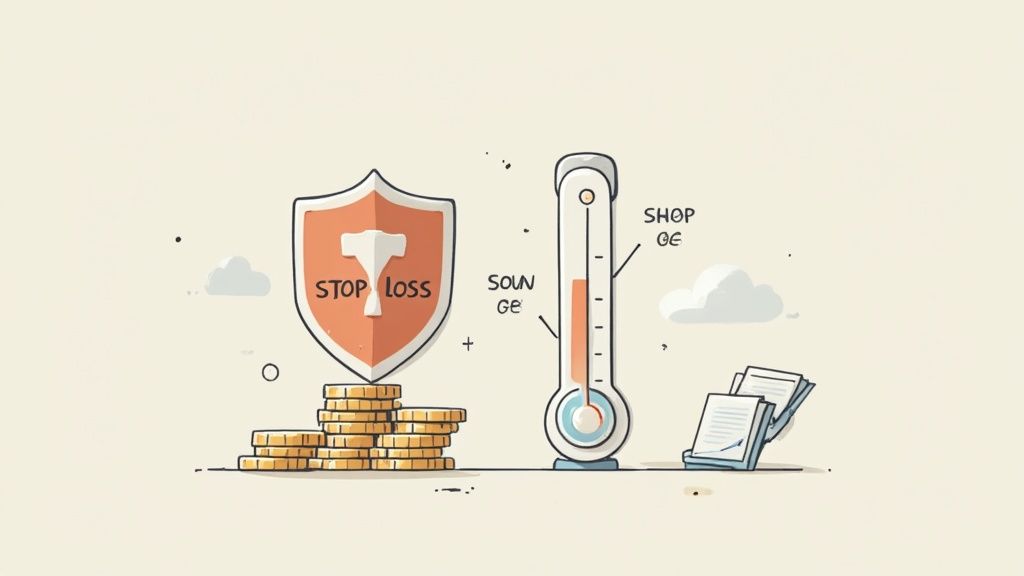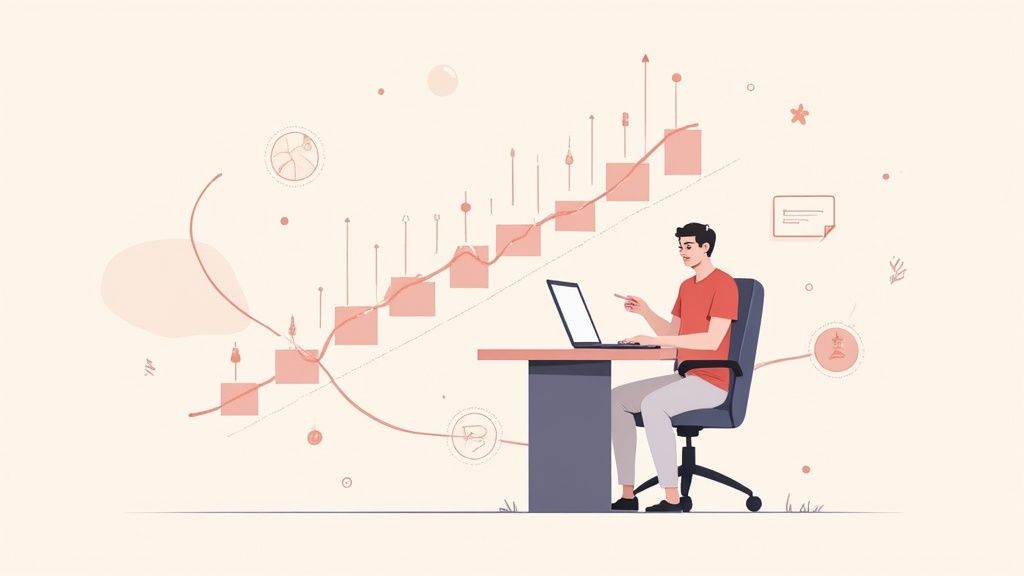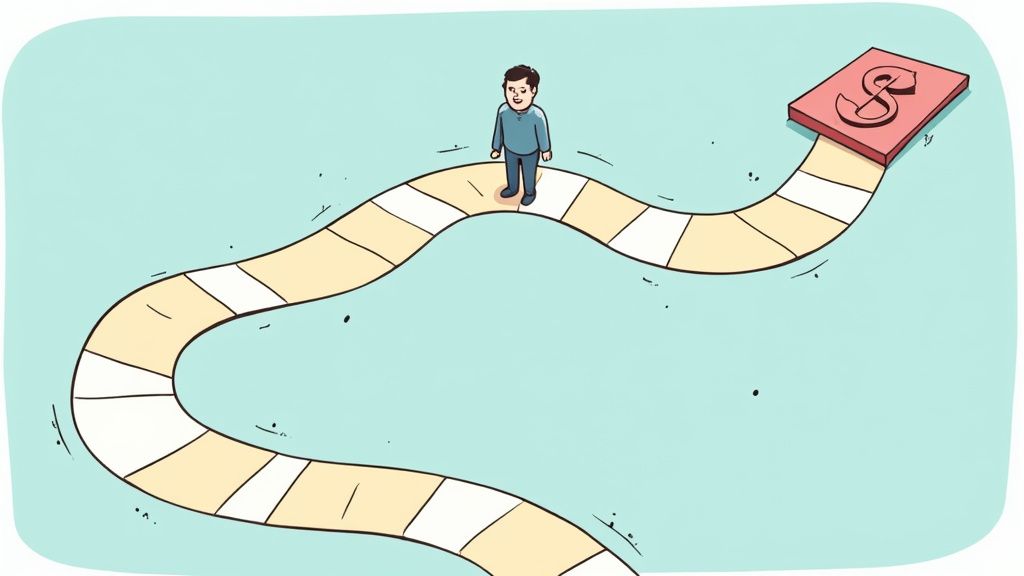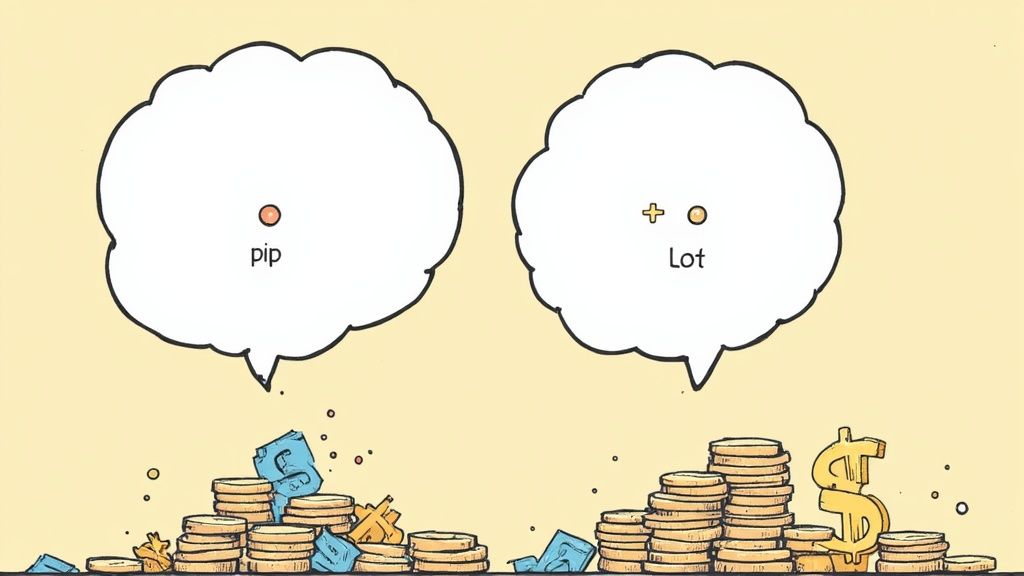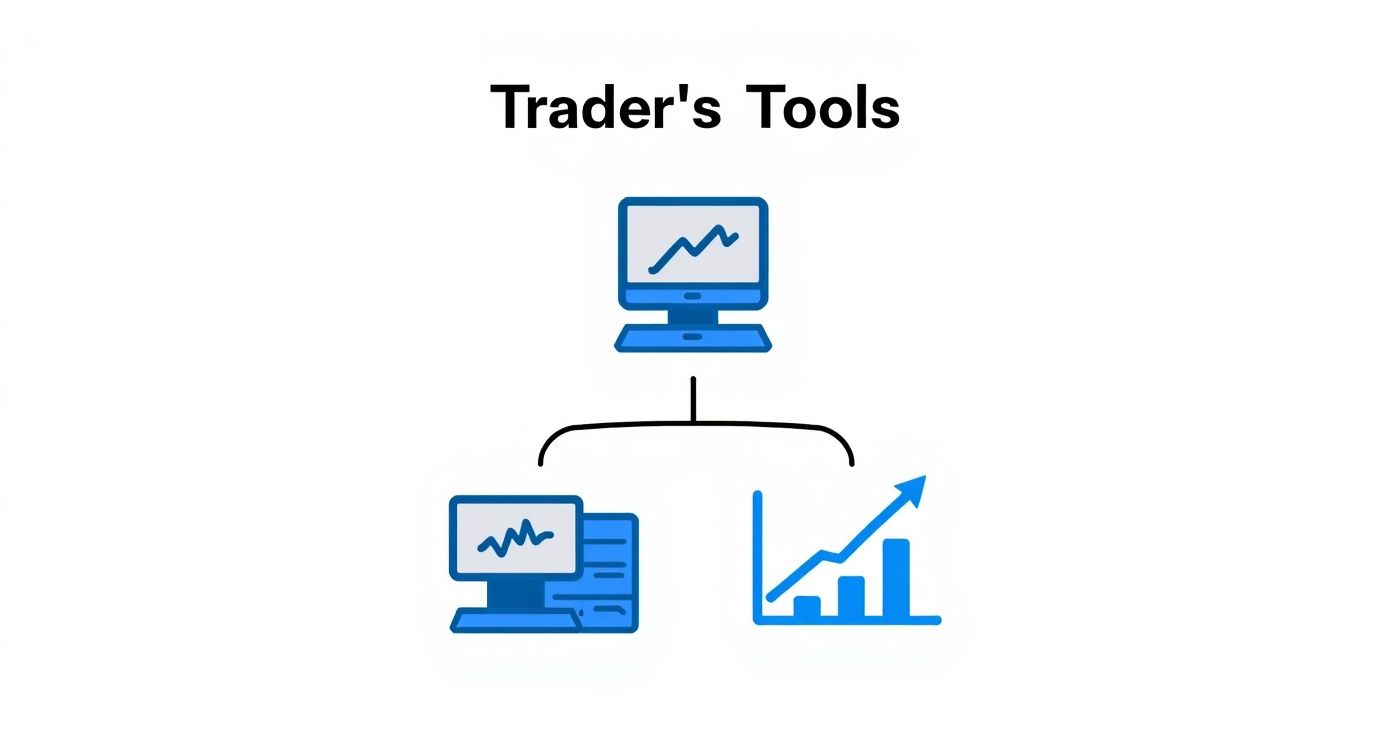Ready to jump into the world of currency trading? Think of this forex trading for beginners pdf as your personal roadmap. We've built it to cut through the noise and make learning about the world's biggest money market simple and-dare we say-exciting. No confusing jargon, we promise.
Your Journey into Forex Trading Starts Here
Picture the forex market as a giant, non-stop global arcade. It's where currencies like the US Dollar and the Japanese Yen are swapped 24 hours a day. You've probably heard wild stories about traders making fortunes overnight. While that's super rare, it's not just for Wall Street pros. Even celebrities like Ashton Kutcher have dabbled in trading, showing it's more accessible than ever.
The truth is, anyone can learn the basics. This guide is designed to help you get the core concepts, one step at a time. This isn't about getting rich quick; it's about building a solid, lasting skill. As legendary trader Paul Tudor Jones said, "The secret to being successful from a trading perspective is to have an indefatigable and an undying and unquenchable thirst for information and knowledge."
Here's a little sneak peek of the guide you're about to explore.
This cover isn't just for show-it represents the clean, step-by-step approach we take inside, turning complex ideas into lessons you can actually use.
What You Will Learn
This PDF isn't just a random collection of facts. We’ve laid out a structured path to build your confidence from the ground up. Here’s a quick look at what we'll cover together:
- The Absolute Basics: We'll start with the simple stuff-what forex is, why it even exists, and who the major players are. All in plain English.
- Core Lingo: You'll get comfortable with essential terms like 'pips', 'leverage', and 'currency pairs' without feeling like you're cramming for a test.
- Practical First Steps: We'll walk you through setting up a completely risk-free practice account. This is huge because you can apply what you learn with zero pressure.
- Simple Strategies: Discover a few easy-to-understand trading strategies that are perfect for someone just finding their footing.
As you start your investment journey, you might also find some helpful insights for young investors that can add another layer to your understanding. Our main goal here is to give you a strong foundation so you can explore the market smartly and safely.
Understanding Currency Pairs, Pips, and Leverage
Let's get into the real stuff. It all starts with the basics, and the most fundamental concept is the currency pair. Think of it like swapping your money for Euros when you go on a trip to Europe-that's the core idea.
In the forex market, you're never just buying or selling a single currency. You're always trading one for another, which is why they come in pairs. You'll see things like EUR/USD (the Euro vs. the U.S. Dollar) or USD/JPY (the U.S. Dollar vs. the Japanese Yen). The first currency is the "base," and the second is the "quote."
When you see a price like EUR/USD = 1.08, it just means one Euro is worth 1.08 U.S. Dollars. You're basically betting on which currency you think will get stronger or weaker. To get a deeper dive, check out this guide on how to read currency pairs.
Counting the Smallest Moves With Pips
So, how do you track the tiny price changes in these pairs? That's where the pip comes in. A pip, which stands for "Percentage in Point," is the smallest standard move a currency pair can make. It's like scoring a single point in a massive, fast-paced video game.
For most major pairs like EUR/USD, a pip is the fourth number after the decimal point (0.0001). If the price moves from 1.0800 to 1.0801, that’s a one-pip move. These tiny changes might not seem like much, but when you're trading larger amounts of money, they add up very quickly.
This infographic breaks down the essential knowledge, risk awareness, and practice you need to get started on the right foot.
As you can see, getting a handle on concepts like pips and pairs is just the first step. A solid foundation is everything.
Using Leverage: The Financial Power-Up
Now, let's talk about one of the most exciting-and potentially dangerous-tools: leverage. Think of leverage like a power-up in a game. It's a loan from your broker that lets you control a large amount of money using only a small piece of your own.
For instance, with 100:1 leverage, you could control a $10,000 position with just $100 from your account. This makes those small pip movements much more impactful, meaning your potential profits can get a huge boost.
"The key to trading success is emotional discipline. If intelligence were the key, there would be a lot more people making money trading." – Victor Sperandeo
This quote really hits home when you're using leverage. While it can amplify your wins, it works both ways-it also magnifies your losses just as fast. A trade moving against you can wipe out your initial deposit much quicker than you’d expect. Leverage is a powerful tool, but it demands respect and a solid risk management plan.
It’s important to understand the sheer scale of the arena you're stepping into. The table below shows just how massive the forex market is.
Forex Market Volume and Who's Playing
| Participant | Average Daily Volume | Retail Share |
|---|---|---|
| Big Banks & Institutions | ~$6.4 Trillion | 94.3% |
| Retail Traders (like you) | ~$385 Billion | 5.7% |
| Total Global Market | ~$6.8 Trillion | 100% |
| Source: BIS Triennial Survey, 2019, adjusted for retail estimates. |
The global forex market is the largest financial market in the world. But as you can see, regular people-that's us-make up a tiny slice of the pie. The big fish are huge banks and hedge funds. You're swimming in a big ocean, so it pays to be prepared.
How The Forex Market Actually Works
Imagine the forex market as a global relay race that never stops. Thanks to different time zones, trading runs 24 hours a day, five days a week. When the market in New York closes, the one in Sydney is just getting started.
A few big players keep things moving. Giant international banks trade huge amounts every second. Central banks-like the U.S. Federal Reserve-jump in to manage their economies. Add in multinational corporations and retail traders, and you have constant action.
Most of this trading happens in big financial cities like London, Tokyo, and New York, which creates busy periods with lots of activity.
There isn’t a single building you can visit. Instead, everyone connects through a massive electronic network. This makes forex the most liquid market on Earth-someone is always ready to buy or sell.
The Real Price Of A Trade
Imagine you're selling a rare pair of sneakers. You list them for $300 (the ask price), but buyers might only offer $280 (the bid price). That $20 gap is the bid-ask spread. It's how the platform or broker makes a small fee for connecting you.
In forex, these spreads are often less than a penny. Brokers compete to have the smallest spreads, so finding a good one can save you money.
Did you know the U.S. Dollar (USD) is involved in nearly 88% of all forex trades? It's like the main character in the story of global currency.
Giving Your Platform Orders
You can’t just yell “Buy!” at your computer. Trading software needs clear commands-called orders-to do what you want. You’ll find these on every platform, including popular ones like MetaTrader 4.
- Market Order: Hit the button, and your trade happens instantly at the best price available. It's fast, but you don't control the exact price.
- Limit Order: You set the price. For example, "buy EUR/USD if it drops to 1.0750." The trade only happens if it hits your price.
- Stop Order (Stop-Loss): This is your safety net. You set a price to automatically close your trade to prevent big losses if the market goes against you.
“The goal of a successful trader is to make the best trades. Money is secondary.” – Alexander Elder
These orders are the building blocks of trading. You'll see them in every good PDF guide on forex basics.
By mastering these simple ideas, you start trading with a plan instead of just reacting to the market.
Setting Up Your First Trading Account
Okay, let's move from learning to doing. Setting up your first account is like getting the keys to a high-tech racing simulator. You can learn the controls, feel the speed, and crash a few times without any real-world damage.
The most important first step is choosing a good broker and opening a demo account. A demo account is your personal, risk-free playground funded with "play money." It's where you build your trading skills, test strategies, and make all the beginner mistakes without losing a single dollar.
"I will keep myself practicing, training, and learning. I will work when I am resting, and I will be resting when I am working." – 50 Cent
He might be a rapper, but 50 Cent’s mindset is perfect for trading. The demo account is your training ground. It's where you practice until placing trades feels like second nature.
Getting Started With Trading Software
Once you've picked a broker, you'll need a trading platform. This is your command center. Most beginners start with MetaTrader 4 (MT4) or its newer version, MetaTrader 5 (MT5).
Getting it is super simple:
- Choose a Broker: Find a trusted broker that offers a free demo account and supports MT4 or MT5.
- Download the Software: Go to your broker’s website and find the download link for the platform.
- Install and Log In: Run the installer and use the demo account details your broker emails you.
The whole process is quick and easy. This is where the real learning from this forex trading for beginners pdf starts to happen.
Here’s a look at the clean, simple interface of MetaTrader 4. Everything you need-charts, account info, and trading tools-is right there.
From this screen, you can check out different charts, add tools to analyze prices, and place your first few practice trades with just a couple of clicks.
Your First Practice Trades
Now that you're set up, it’s time to get a feel for the controls. Don't worry about complex strategies yet. The only goal is to get comfortable with the software.
Start by just clicking around. Learn how to open a chart for a major pair like EUR/USD. Then, try placing a simple "buy" and "sell" order. Watch how the prices change and see your virtual profit or loss move with the market.
This hands-on experience is priceless. It turns all the abstract ideas from this guide into real skills. This practice is what will get you ready for the real market when the time comes.
Simple Forex Strategies You Can Use Today
Alright, now for the fun part-learning a few game plans.
You don't need a super-complex strategy to get started. In fact, keeping it simple is one of the smartest things you can do. Let’s look at three popular approaches perfect for beginners.
The goal isn't to find a magic strategy that never loses. That doesn't exist. Instead, you want a clear set of rules to help you make decisions with your head, not your emotions.
Riding the Wave With Trend Following
Trend following is exactly what it sounds like: you find a clear market direction and ride it. If the price is consistently going up (an uptrend), you look for chances to buy. If it's consistently going down (a downtrend), you look for chances to sell.
Think of it like swimming in a river-it's much easier to go with the current than against it. Trend followers use simple tools, like moving averages, to help see which way the "current" is flowing.
This is a classic for a reason. Even the legendary George Soros, who famously made over $1 billion in a single day betting against the British Pound, was basically making a huge bet on a powerful currency trend.
Catching the Breakout
A breakout strategy is about timing. Traders watch for prices to get stuck in a tight range, bouncing between a price floor (support) and a price ceiling (resistance). When the price finally smashes through one of those levels, it can signal the start of a big new move.
Breakout traders are like sprinters waiting for the starting gun. They find these key levels and get ready to trade the moment the price "breaks out." A breakout above the ceiling is a signal to buy, while a drop below the floor is a signal to sell.
"The market can stay irrational longer than you can stay solvent." – John Maynard Keynes
This famous quote is a great reminder for breakout traders. Sometimes, a price will poke through a level and then snap right back. This is called a "fakeout." That’s why having a stop-loss order is an absolute must with this strategy.
To get better at spotting these patterns, you first need to understand the basics. Our detailed guide on how to read forex charts is the perfect place to build that foundational skill.
Trading Within the Lines: Range Trading
So what happens when the market isn't trending up or down? Sometimes, it just bounces back and forth between two clear price levels, like a ping-pong ball. This is called a ranging market.
Range traders aim to buy near the bottom of the range (the floor) and sell near the top (the ceiling). This strategy works best when the market is quiet and there isn't any big news pushing prices in one direction. The key is to find a clear and predictable channel.
Common Forex Strategies At A Glance
To start, you don't need to master every strategy. It's much smarter to understand a few simple ones and know when to use them. Each approach fits a different market mood. Here’s a quick comparison of the strategies we just covered.
| Strategy | Typical Timeframe | Risk Level |
|---|---|---|
| Trend Following | Medium to Long-Term (Hours to Weeks) | Medium |
| Breakout Trading | Short to Medium-Term (Minutes to Days) | High |
| Range Trading | Short-Term (Minutes to Hours) | Low to Medium |
Think of these as your first three plays in your trading playbook. None of them work all the time, but by understanding the market's behavior, you can choose the right tool for the job.
Remember, this entire forex trading for beginners pdf is designed to give you a solid starting point. Get comfortable with these ideas in your demo account first. Practice spotting trends, ranges, and breakouts. And always, always manage your risk.
How to Manage Risk and Protect Your Money
Alright, let's talk about the single most important lesson in trading. The real secret to staying in the game long enough to succeed is learning how to play defense. It’s not just about winning-it’s about making sure you never lose too much.
Think of your trading money like your phone's battery. You have a certain amount, but if you waste it all on one power-hungry app, you're done for the day. Trading is the same. You have to protect your capital so you can keep making smart moves.
Your Most Important Tool: The Stop-Loss Order
Let's talk about your personal financial bodyguard-the stop-loss order. This is a simple command you give your platform to automatically close a losing trade once it hits a certain price. It’s your emergency exit.
Imagine you buy a currency, hoping it’ll go up. Instead, it starts to drop. Without a stop-loss, you might stare at the screen, hoping it turns around while your losses get bigger. A stop-loss takes the emotion out of it, closing the trade at a level you decided was okay before you even entered.
For any beginner, this is a must. Here's why:
- It Limits Your Losses: You decide exactly how much you're willing to risk on any single trade. No ugly surprises.
- It Fights Emotion: It stops you from holding onto a losing trade out of pure hope-a classic and expensive mistake.
- It Frees You Up: You don't have to be glued to your screen. Set it and go live your life.
Think of it as a safety net. You hope you never need it, but you'd be crazy to trade without one. This idea is the foundation of any good forex trading for beginners pdf.
The Golden Rule of Risk Per Trade
So, how much should you actually risk? The pros follow a simple but powerful rule: never risk more than 1% to 2% of your total account on a single trade. If you have a $1,000 account, your maximum loss on any one trade should be just $10 to $20.
I know, that sounds super small. But trust me, it's the secret to survival. This tiny risk ensures that even five or six losses in a row won’t knock you out of the game. It gives you room to be wrong, learn, and trade another day.
"It's not whether you're right or wrong that's important, but how much money you make when you're right and how much you lose when you're wrong." – George Soros
This quote from billionaire investor George Soros says it all. Controlling your losses is just as important-if not more so-than chasing profits. Fun fact: a 50% loss in your account requires a 100% gain just to get back to where you started. That's some tough math.
Avoiding The Mental Traps
Finally, you have to manage the biggest risk: your own emotions. When you lose money, it's natural to feel frustrated and want to win it back fast. This leads to "revenge trading," where you make bigger, riskier trades to make up for a loss. This almost never ends well.
The hard truth is that most beginners don't make it. Globally, only about 15% of retail forex traders are profitable over time, with major brokers reporting that between 72% and 84.6% of their clients lose money. If you want to be in the small group that succeeds, you must have the discipline to walk away after a loss and stick to your plan. You can discover more about these trading statistics and see for yourself why so many struggle.
Protecting your money is about having a plan and, most importantly, the discipline to follow it-no matter what.
So, What's Next?
Congratulations, you’ve made it through the forex trading for beginners pdf. Think of it like this: you've just passed your driver's written test. You know the rules of the road, but that's totally different from driving in rush hour traffic. Now it’s time to get behind the wheel.
Your first and most important stop is the demo account. This isn't about getting a high score with fake money. It’s your simulator. The goal is to build routines, get a real feel for the market, and become completely comfortable with your platform. Treat it as your personal training ground.
Building Your Action Plan
To get the most out of your practice, don't just click buttons randomly. Even with play money, you need a plan. Here's a simple framework to get you started:
- Keep a Trading Journal: Seriously, write everything down. Why did you take that trade? What was your plan? How did you feel? This log will become your best tool for finding your strengths and weaknesses.
- Follow the News: Make it a daily habit to check financial news. Understanding the why behind market moves is just as important as reading a chart.
- Master One Thing: It's tempting to try every strategy you see. Don't. Pick one simple setup from this guide and practice it over and over until you know it inside and out.
"I fear not the man who has practiced 10,000 kicks once, but I fear the man who has practiced one kick 10,000 times." – Bruce Lee
This couldn't be more true for trading. Focus on becoming an expert in one simple approach. Consistency is what separates successful traders from everyone else.
Here at financeillustrated.com, our goal is to make this journey as straightforward as possible. Keep sharpening your skills with our free trading simulators and easy-to-digest lessons.
